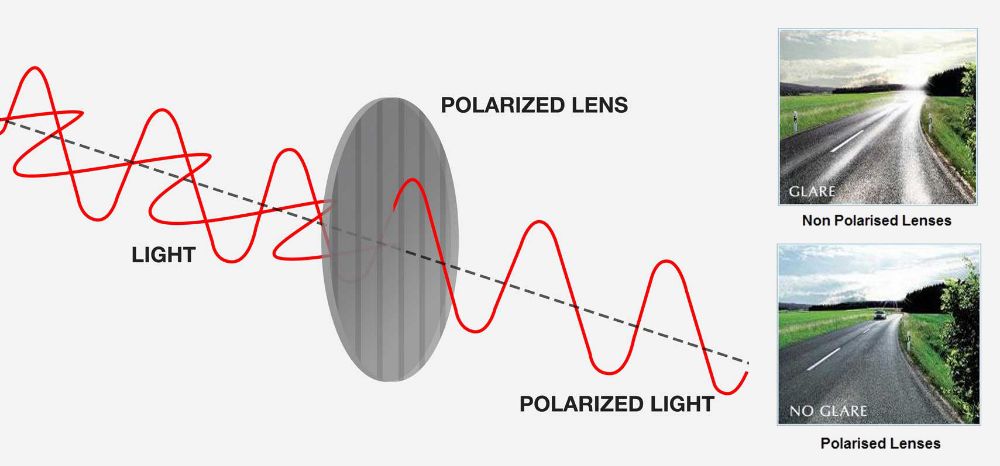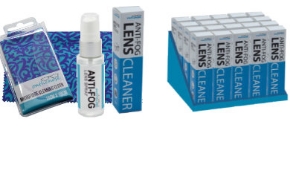Polarised Lenses
All about polarised sunglasses
We’ve all experienced glare in our daily lives… perhaps spending the day at the beach, driving in a car with the sun reflecting off the dashboard, roadway or bonnet or on a boat with the sun illuminating the surface of the water. Usually, this glare is annoying and uncomfortable on the eyes, but when the angle of reflection is just right, the glare can become blinding and often downright dangerous, as in the case of driving a vehicle. Ordinary tinted sunglass lenses only cut down on ambient light that reaches the eye, or, light transmittance. By their very nature, they cannot block glare. Only polarised lenses can block out this dangerous, blinding glare. To understand how, you will need to understand how glare works and how polarised lenses work.

What is Glare?
When light is generated from a light source (eg the sun) the light waves are oriented randomly in different planes - vertical, horizontal and everything in between. When these waves hit a reflective object (water, snow, glass, car bonnet, etc), waves moving in the horizontal plane are reflected. Most of the other light is either absorbed (think of a black tarmac road) or transmitted (creating a reflection). At one particular angle (Brewster's Angle) the reflected light is completely horizontally polarised. The reflected horizontally polarised light is only a particular problem when it is coming from a bright light source, typically the sun. The reflection of the light from this intense light source directly into your eye is what we call glare, and it can dangerously interfere with your vision due to it's intensity. Fortunately, a polarised lens has the ability to stop specifically these reflected horizontally polarised waves.
What is a Polarised Lens?
Polarised lenses are laminated with tiny vertical stripes that only allow vertically angled light to enter the wearer's eyes. Glare is eliminated because the horizontally polarised light waves cannot bypass the vertical filter.
Polarised lenses contain millions of parallel rows of tiny iodine crystals or dichroic dyes (so small they can’t be seen with the naked eye).
Like venetian blinds, the horizontal rows of iodine crystals contained within the polarised lens block out horizontal polarized light waves, letting only (non-polarised) vertical light waves reach the eye. Polarisation blocks as much as 50% of the light passing through a lens. The person looking through the lens can still see clearly in most cases, but it reduces the brightness and glare of light.
This results in comfortable vision with no glare, and is the reason why only a polarised lens can block glare.
Different Types Of Polarised Glasses & Lenses:
Lenses can be polarised to different degrees and in different ways. Most inexpensive polarised sunglasses have a thin film applied on one side of the lens. Many higher quality lenses have film laminated between two layers of lens material, preventing it from being scratched or rubbed off. In addition, the more dense the film is, the more polarisation it provides.
In most cases, polarised sunglasses don't look any different from regular sunglasses. While denser films tend to be darker, the colour of a lens does not determine how much polarization it provides. A very dark pair of sunglasses with a light film will not block more glare than a lighter shade of glasses with a denser film. The colour of the lens is also variable; although they cannot be made clear, polarised lenses can be made in gray, brown, green, or other colours.
Polarised Lens Benefits:
Drivers, fisherman, and photographers were some of the first to use polarised lenses.
Reducing glare can ease the eye strain drivers feel from long hours on the road. Fishermen can often see under the surface of water using the lenses, which helps them to see fish or other objects. Photographers use polarising filters on camera lenses to enrich the images they capture by giving them more contrast, and to increase the range of effects they can produce. In addition to blocking blinding glare, polarised lenses can also help you to see better by improving contrast and visual comfort and acuity.
Polarised Lens Limitations:
Because the polarising stripes reduce the amount of light entering the eye, these lenses should not be used at night or in other situations where clear lenses are required.
Polarised lenses can cause distortions in the way wearers see liquid crystal displays (LCDs), rendering some cell phone screens, clocks, and other displays unreadable.
Pilots should not use polarised glasses because they can make flight instruments difficult to read and other objects in the sky — including other airplanes — less visible.







